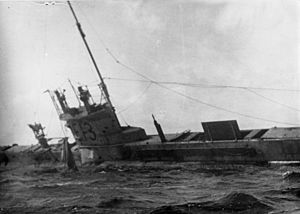British submarine flotilla in the Baltic facts for kids
A group of British submarines operated in the Baltic Sea for three years during the First World War. This special squadron of nine submarines worked closely with the Russian Baltic Fleet. Their main job was to stop iron ore from Sweden reaching Imperial Germany. This was important because iron ore was used to make weapons and other war supplies.
The submarines were very successful. They forced the German Navy in the Baltic to stay in their bases. This also meant the powerful German High Seas Fleet couldn't use the Baltic Sea for training. The British submarine group was based in Reval (which is now Tallinn, the capital of Estonia). For most of the war, Captain Francis Cromie was in charge of the flotilla.
The group first had six large E-class and five smaller C-class submarines. The C-class subs traveled to the Baltic Sea through northern rivers, starting from the White Sea. The bigger E-class submarines made a tricky journey. They managed to sneak through the narrow and shallow Danish Straits without being seen by the Germans. During their time, two submarines were lost because they ran aground. Another one went missing and is thought to have been sunk by a mine.
In 1918, things changed. German forces took over Tallinn, and a peace treaty called the Treaty of Brest-Litovsk was signed. This forced the British submarines to move to Helsinki, in Finland. They hoped to be safe there under the protection of the Finnish Socialist Workers' Republic. However, Germany then got involved in the Finnish Civil War. German troops, about 10,000 strong, landed in Hanko. This meant the British crews had to sink their eight remaining submarines and three support ships (Cicero, Emilie, and Obsidian). They sank them outside Helsinki harbour to stop the Germans from capturing them.
A similar thing happened to the Russian submarines working with them. After a difficult journey called the Ice Cruise of the Baltic Fleet, four Russian Holland type submarines were left without support in Hanko. When German troops arrived on April 3, the Russians quickly sank their submarines, including AG 12 and AG 16, in Hanko harbour.
Contents
Submarines of the Flotilla

E-Class Submarines
The E-class submarines entered the Baltic Sea through the Danish Straits. These waters were very shallow, only about 33 feet (10 meters) deep. On August 19, 1915, HMS E13 got stuck in The Sound near Saltholm. German torpedo boats attacked and destroyed her, even though it was against Danish neutrality. Fifteen crew members were lost. The other E-class submarines managed to get into the Baltic without being stopped by the Germans. HMS E18 and E19 safely reached Reval in September 1915.
- HMS E9, led by Max Horton, stopped four German cargo ships on October 18–19, 1915.
- HMS E18 was lost in the Baltic Sea in May 1916. It was operating from Reval at the time. When its wreck was found near Hiiumaa, Estonia, in 2009, it looked like it hit a naval mine while sailing on the surface.
- HMS E19, commanded by Francis Cromie, stopped four German cargo ships on October 10–11, 1915. It also sank the German warship SMS Undine.
The last four E-class submarines—HMS E1, E8, E9, and E19—were sunk on purpose outside Helsinki in 1918. They were scuttled (sunk by their own crews) south of the Harmaja Light. This was done to prevent them from being captured by German troops who had landed nearby.
C-Class Submarines
Four C-class submarines were sent to the Baltic in September 1915. They took a very long and difficult route. They were towed around the North Cape to Archangelsk in Russia. From there, they were put on barges and taken through the Dvina and Sukhona rivers to Vologda. Then they traveled across Lake Onega and Lake Ladoga to Petrograd (now St. Petersburg). HMS C26, C27, C32 and C35 reached Saint Petersburg on the Gulf of Finland on September 9, 1916. However, they had problems with their batteries and could only start full operations in 1917.
- HMS C32 got stuck on a mudbank near Pärnu on October 24, 1917. This happened while it was trying to stop Operation Albion. This was a German plan in October to invade the Estonian islands of Saaremaa, Hiiumaa, and Muhu.
Three of these C-class boats—HMS C26, C27, and C35—were also scuttled outside Helsinki in 1918, just like the E-class submarines.
What Happened Next
The crews of the scuttled submarines were taken by Soviet ships to Petrograd. From there, they traveled by train to Murmansk. They joined the Allied forces helping in North Russia. This happened only a few weeks before fighting cut off the railway lines to Murmansk.
Some of the officers from this flotilla later became important leaders in the British Royal Navy Submarine Service. These included Sir Noel Laurence and Sir Max Horton, and Vice Admiral Leslie Ashmore. Admiral Aksel Berg also worked as a contact officer from the Imperial Russian Navy. He later became the Deputy Minister of Defence for the Soviet Union (1953–57).
In 1935, Britain and Germany signed an agreement called the Anglo-German Naval Agreement. This allowed Germany to make its navy, called the Kriegsmarine, one-third the size of the British Royal Navy. This would have given the German navy a lot of power in the Baltic Sea.
Before World War II, some people in Finland tried to raise parts of the scuttled British submarines. But they realized the submarines were too damaged to fix. So, they put them back into the sea. It is believed that a German company raised the remains in 1953. They were likely used as scrap metal. The wreck of the support ship Cicero is thought to have been found in 1995.
See also
- Swedish iron ore during World War II
- Operation Catherine
Images for kids
-
HMS E18 after passing through the Oresund in September 1915


